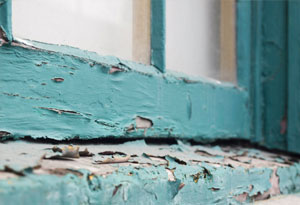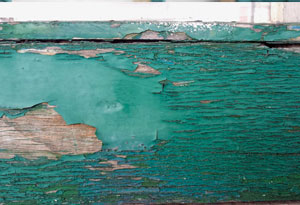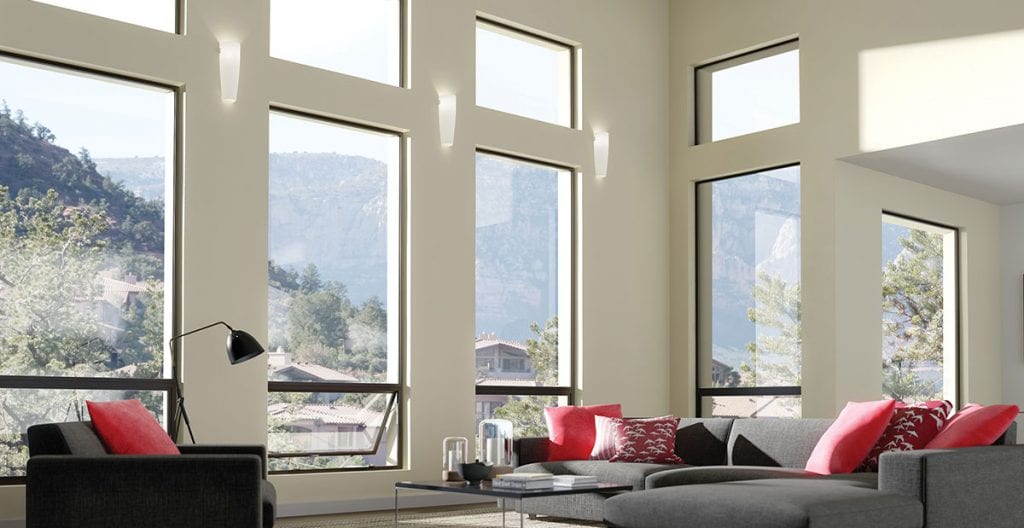When considering replacement windows for your home, it’s important to remember that your old painted wood windows, frames or walls may contain dangerous lead in the paint.
Lead exposure can cause serious illness, especially in children. So the presence of lead paint is one very important reason to consider replacing your windows. However, it’s important to hire an experienced and licensed window installation company, who can mitigate any risks from your old window’s or wall’s lead based paint.
In this article we explain the dangers of lead painted windows, how to tell if you are at risk, and what to do to safely replace them, so your family is not at risk.
Why Is Lead Paint Dangerous?
 Even small amounts of lead can cause serious health problems in adults and children. Lead poisoning occurs when lead builds up in the body over time. Children younger than 6 years old are especially at risk to lead poisoning, which can profoundly affect their mental and physical development.
Even small amounts of lead can cause serious health problems in adults and children. Lead poisoning occurs when lead builds up in the body over time. Children younger than 6 years old are especially at risk to lead poisoning, which can profoundly affect their mental and physical development.
Lead-based paint and dust from lead-contaminated paint are the most common sources of lead poisoning in children. And by some accounts, up to 90% of lead poisoning cases from paint in children are caused by older windows.
Research has shown that just opening and closing windows generates enough lead-paint dust to poison children, decades after the lead paint was applied.
Health effects in adults can include: high blood pressure; joint and muscle pain; memory loss; headaches; mood disorders; and stomach problems. Reproductive issues such as reduced sperm count, abnormal sperm, miscarriage, stillbirth or premature birth can also be caused by lead exposure.
People who seem healthy can still have high blood levels of lead, with symptoms that don’t appear until down the road, when dangerous amounts of lead have accumulated. At very high levels, lead poisoning can even be fatal.
How Do I Know If I Have Lead Paint on My Windows?
If your home was built before 1978, there is a good chance it may have lead-based paint somewhere – especially if you still have the original windows.
The Lead-Based Paint Poisoning Prevention Act of 1971 restricted, but did not ban, lead content in paint used in housing. Subsequent, in 1976, the Consumer Product Safety Commission was created and they effectively banned leaded paint. By 1978, the federal government had banned consumer uses of all lead-containing paint.
However, lead paint is still present in millions of homes in the United States, sometimes under layers of newer paint. If the top coatings of paint are in good shape, the lead paint is usually not a problem. However, any peeling, scratched, chipping, cracking, damaged, or damp surface with underlying lead paint is a poisoning hazard and needs immediate attention.
Here’s how to know if your home’s windows or other surfaces have lead paint:
- If any of the paint is from the 1970s, or earlier, it very likely contains lead.
- You can also buy a home testing kit for lead-based paint at the Lowes or Home Depot. However, these home tests are not always 100% reliable.
- Contact your local department of health or a lead testing service in your area.
- Have your professional window installer do a lead test before replacing your windows.
I Think I Have Lead Painted Windows – Now What?
 If your old, lead painted windows are risking your family’s health, it is typically better to have them replaced, rather than try to remove the lead paint yourself. Attempting to scrape or sand the old lead based paint can raise even more toxic dust and chips.
If your old, lead painted windows are risking your family’s health, it is typically better to have them replaced, rather than try to remove the lead paint yourself. Attempting to scrape or sand the old lead based paint can raise even more toxic dust and chips.
DIY window repairs or replacement that create even a small amount of lead dust are enough to poison your children and put your family at risk. Replacing windows can require lead containment on both inside and outside unless you hire a contractor who knows how to avoid it.
For this reason, hiring a lead-certified window replacement company is essential. Removing old windows can disturb lead-based paint, creating hazardous lead dust and chips which can be harmful to adults, and especially children, in your home.
The EPA’s Lead Renovation, Repair and Painting Rules (LRRP) require that contractors dealing with painted surfaces in homes built before 1978 must be certified, and follow specific work practices to prevent lead contamination. Always ask to see your window installer’s certification.
In addition to homes, the LRRP Program applies to apartments and child-occupied facilities such as schools and daycare centers built before 1978. So, landlords are also required to protect their residents by following the EPA’s LRPR rules when conducting repairs or renovations such as window replacement.
How Replacement Window Installers Remove Lead Contamination
First, remember that the EPA requires that only certified renovators, who are trained by EPA-approved training providers and follow lead-safe work practices, can perform the work. So step number one is hiring a Lead-Safe Certified Firm, like Can-Do Windows and Doors.
Next, since replacing lead-painted windows is a renovation that can cause lead contamination both inside and outside the house, it may require “containment” on both sides. A Lead-Safe Certified window installer will determine if this is necessary to fully comply with the EPA’s Lead Renovation, Repair and Painting Rules (RRP Rules).
Sometimes during EPA compliant lead window replacement, however, the window installer can choose the best side of the wall to work from, just sealing the opposite side.
In addition, pole and plastic containment shroud systems can be used to contain the disturbed area, also preventing the release of toxic lead into the air.
The installer will also mist the surface with water to keep down the dust, and then carefully cut-out all painted joints to avoid further chipping the paint. Then they will remove all the parts necessary to remove the sash, before pulling out window sash. Finally they will install a completely new jamb liner and a new sash.
Finally, any lead-containing dust or debris, as well as the removed lead-contaminated window pieces must be properly sealed and disposed of in an environmentally safe manner.
Common Questions on Lead Paint:
Can painting over lead paint make it safe?
Yes, you can paint over lead paint. However, you should make sure that the paint you’ll use is encapsulants. Encapsulation is safer than lead paint removal since it doesn’t release lead dust or debris into the air.
Do old windows have lead paint?
According to the Department of Health, many homes built before 1978 have at least some lead-based paint, so it’s safe to assume that a house that old (or older) may contain some lead-based paint.
How do you remove lead paint from windows?
A variety of approaches are used to remove lead-based paints, such as wire brushing or wet hand scraping with liquid paint removers. Your contractor may opt to wet sand surfaces and must use an electric sander equipped with a high-efficiency particulate air (HEPA) filtered vacuum.
Can you get lead poisoning from scraping paint?
Lead paint is very dangerous when it is being stripped or sanded. These actions release fine lead dust into the air. Infants and children living in pre-1960’s housing (when paint often contained lead) have the highest risk of lead poisoning.
Can a homeowner remove lead paint?
You can remove lead paint on your own however you should educate yourself first on lead-safe work practices,
Can you live in a house with lead paint?
If lead paint in your home is deteriorating (chipping, chalking, peeling, damaged, damp, or cracking) it is hazardous especially to children, and needed immediate attention.
Why is lead paint bad?
Based on WebMD, these are the possible effects of lead exposure:
In Children
- Damage to the brain and nervous system
- Kidney damage
- Behavior and learning problems, such as hyperactivity
- Slowed growth
- Nerve damage
- Hearing problems
- Headaches
- Bone marrow problems
In adults
- Anemia
- Fertility problems in both men and women
- Hearing and vision loss
- High blood pressure
- Kidney damage
- Nerve disorders
- Memory and concentration problems
- Muscle and joint pain
Best Costa Mesa Replacement Window Company
 No matter what your budget, Can-Do will come to your home and help you understand your window choices, and compare window options, to ensure you are getting the highest quality, most durable, beautiful and energy efficient windows for the price.
No matter what your budget, Can-Do will come to your home and help you understand your window choices, and compare window options, to ensure you are getting the highest quality, most durable, beautiful and energy efficient windows for the price.
We have installed beautiful, new replacement windows in thousands of homes across the Costa Mesa, Newport Beach, Huntington Beach and South Bay area.
We can also assist you in obtaining easy financing, with no money down, so you can start enjoying your new windows (and lowering utility bills) right away.



